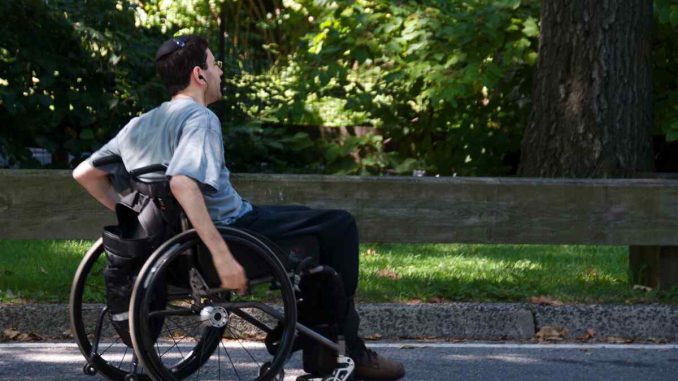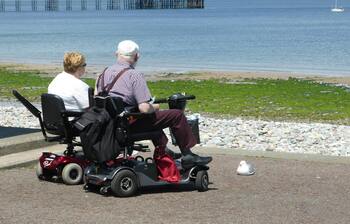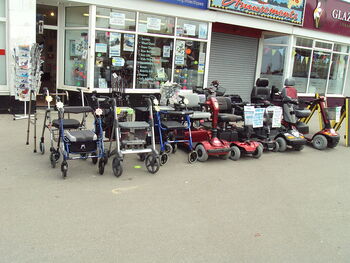
When it comes to mobility solutions, the traditional wheelchair has been a reliable tool for individuals with limited mobility. However, advancements in technology and design have paved the way for a diverse range of wheelchair alternatives that cater to different needs and preferences. In this comprehensive guide, we’ll delve into innovative options that go beyond the conventional wheelchair, providing individuals with enhanced mobility, comfort, and independence.
1. Mobility Scooters
 Overview
Overview
Mobility scooters offer a practical and comfortable alternative to traditional wheelchairs. These electric vehicles are equipped with a seat, handlebars, and a flat area for footrests. Mobility scooters are particularly beneficial for individuals who have difficulty propelling a manual wheelchair or require assistance for longer distances.
Key Features
- Battery-Powered: Mobility scooters are electrically powered, providing a convenient and energy-efficient mode of transportation.
- Adjustable Speed Settings: Users can control the speed of the scooter, making it suitable for both indoor and outdoor use.
- Comfortable Seating: The padded and adjustable seat ensures a comfortable riding experience.
Ideal Users
- Individuals with limited upper body strength.
- Those who require assistance for extended travel.
- People who can maintain an upright seated position.
2. Rolling Walkers with Seat
Overview
Rolling walkers, also known as rollators, combine the support of a traditional walker with the convenience of a built-in seat. These devices typically feature four wheels, brakes, and a seat, providing users with the option to walk, sit, and rest as needed. Rolling walkers are ideal for those who need intermittent support for walking.
Key Features
- Foldable Design: Many rolling walkers are foldable for easy transport and storage.
- Hand Brakes: Users can control their movement and come to a complete stop with hand brakes.
- Storage Pouch: Some models include a storage pouch for personal items.
Ideal Users
- Individuals with stability issues who need occasional seated breaks.
- Those who require support for walking but want the option to rest.
- People with mild to moderate mobility challenges.
3. Knee Scooters
Overview
Knee scooters, also known as knee walkers, are a hands-free alternative to traditional crutches. These devices are designed for individuals recovering from lower leg injuries or surgeries. Knee scooters allow users to rest the injured leg on a padded platform while propelling themselves forward with the other foot.
Key Features
- Padded Knee Rest: The cushioned platform provides support and comfort for the injured leg.
- Steering Handle: Users can navigate easily with handlebars similar to those on a bicycle.
- Adjustable Height: The height of the knee rest is often adjustable to accommodate different users.
Ideal Users
- Individuals recovering from foot, ankle, or lower leg injuries.
- Those seeking a hands-free alternative to crutches.
- People with temporary mobility challenges.
4. Electric Wheelchairs
Overview
Electric wheelchairs, or power chairs, are motorized mobility devices controlled by a joystick or other electronic interfaces. These wheelchairs are suitable for individuals with limited upper body strength or those who prefer not to propel a manual wheelchair. Electric wheelchairs offer a higher level of independence and are available in various configurations.
Key Features
- Joystick Control: Users can navigate the wheelchair with a simple joystick.
- Rechargeable Batteries: Electric wheelchairs are powered by rechargeable batteries for convenience.
- Customizable Options: Some models offer customizable features such as seating options, tilt-in-space, and elevating leg rests.
Ideal Users
- Individuals with limited upper body strength.
- Those who require a higher level of independence.
- People seeking a comfortable and versatile mobility solution.
5. Segways and Personal Transporters
Overview
Segways and personal transporters represent a modern and innovative approach to personal mobility. These self-balancing devices are controlled by the rider’s movements, providing an efficient means of transportation for short distances. While not a traditional wheelchair alternative, they offer a unique option for individuals with specific mobility needs.
Key Features
- Self-Balancing Technology: The device responds to the rider’s body movements for intuitive control.
- Compact Design: Segways and personal transporters are compact and easy to maneuver in tight spaces.
- Electric-Powered: Many models are electrically powered and eco-friendly.
Ideal Users
- Individuals with good balance and stability.
- Those seeking a fun and efficient mode of transportation for short distances.
- People with mobility challenges looking for an alternative to traditional devices.
6. Off-Road Wheelchairs
Overview
For those who love outdoor activities, off-road wheelchairs provide an adventurous alternative to traditional models. These wheelchairs are designed to navigate rough terrains such as trails, grassy areas, and uneven surfaces, offering users the freedom to explore nature.
Key Features
- Sturdy Construction: Off-road wheelchairs are built with durable materials to withstand challenging terrains.
- Large Wheels: Oversized wheels provide stability and traction on uneven surfaces.
- All-Terrain Capability: Users can enjoy outdoor activities without limitations.
Ideal Users
- Individuals with an adventurous spirit.
- Those who enjoy outdoor activities like hiking and camping.
- People seeking a wheelchair capable of handling various terrains.
Choosing the Right Alternative
- Assess Mobility Needs:
- Consider the specific mobility challenges you face and choose an alternative that addresses those needs effectively.
- Consult Healthcare Professionals:
- Before making a decision, consult with healthcare professionals, including physical therapists and mobility specialists, to determine the most suitable option for your condition.
- Test and Try:
- Whenever possible, test different alternatives to assess comfort, ease of use, and compatibility with your lifestyle.
- Consider Lifestyle and Preferences:
- Choose a mobility solution that aligns with your lifestyle and preferences, whether you prioritize outdoor activities, need a compact design for urban living, or require an option for occasional seated breaks.
- Budget Considerations:
- Evaluate the cost of each alternative, factoring in any additional features, maintenance requirements, and potential insurance coverage.
Conclusion
In the realm of mobility solutions, wheelchair alternatives offer a diverse array of options tailored to individual needs and preferences. Whether you opt for a mobility scooter, knee scooter, rolling walker, or an innovative personal transporter, the key is to find a solution that enhances your independence and accommodates your lifestyle. As technology continues to advance, the landscape of mobility options will likely expand, providing even more choices for individuals seeking personalized accessibility solutions. By exploring these alternatives, you can embark on a journey towards improved mobility, comfort, and an enriched quality of life.


Leave a Reply